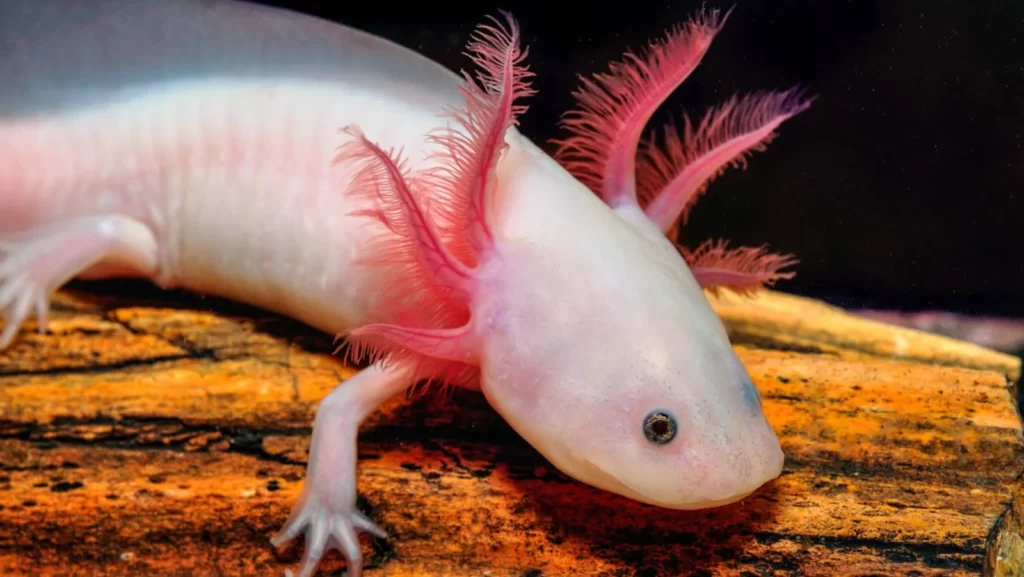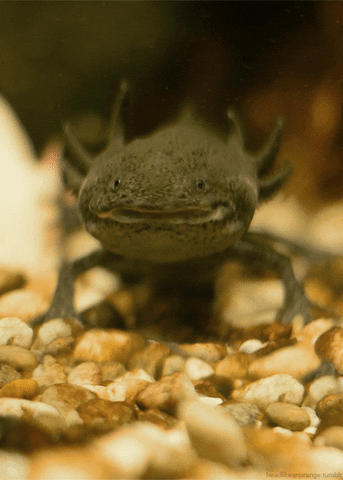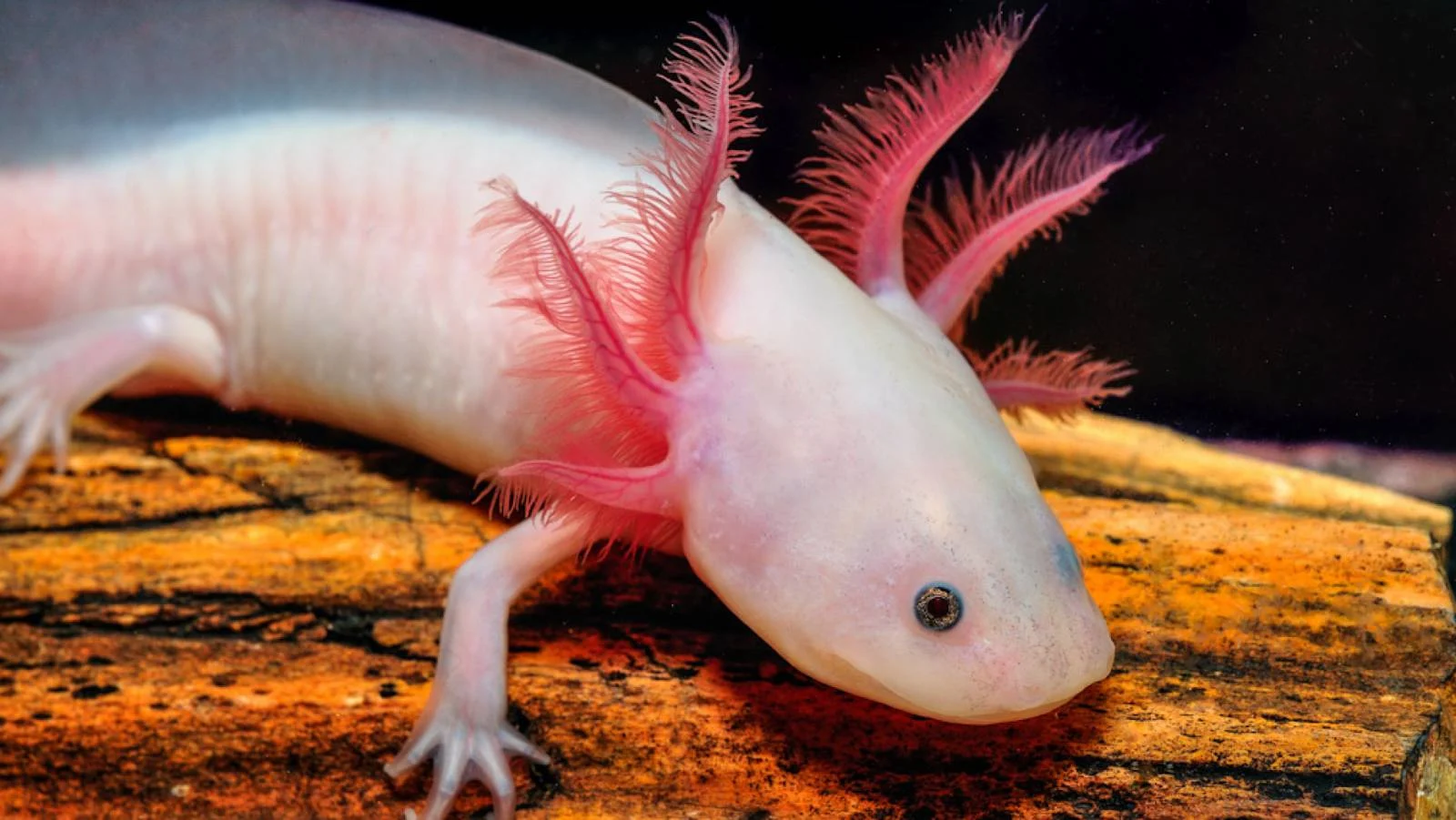The “Axolotl” is the name of a variety of animals that are part of the amphibians group, specifically salamanders.
It is a uniquely appearing creature, resembling a giant tadpole, with a smiling appearance, plume-like gills, tail, fins, and even legs.
Moreover, it is capable of regenerating all parts of its body! It has been considered a succulent food since pre-Hispanic times, with medicinal and aphrodisiac properties.
Currently, it is classified as an endangered species, mainly due to the desiccation of its environment, deforestation, and climate change.
Want to know more about this enigmatic animal that has captured the attention of scientists around the world?
Let’s take a look!
What is an Axolotl?
It is a urodele amphibian; that is, it is equipped with a tail and is part of the salamanders, the family “Ambystomatidae,” and the genus “Ambystoma,” a very curious name that comes from “ambys” meaning blunt and “stoma” or mouth.
It also has fins, legs, and plume-like gills; some species maintain larval form (do not undergo changes or metamorphosis) throughout their life.
Characteristics of the Axolotl
- Its body is gelatinous and elongated; generally, the female is thicker.
- The head is wide, with small eyes and lacks eyelids.
- The mouth is large, with tiny teeth arranged in rows at the entrance of the oral cavity and a retractable tongue (like that of frogs).
- At the neck level, the gills protrude, lateral structures (three pairs) resembling small horns coated with filaments, useful for breathing or exchanging gases.
- It can also breathe through the mouth, lungs, and skin.
- It has four legs, with long fingers (four on the front legs and five on the back), and without nails.
- Its color varies between black, brown, dark gray, pale pink (albino), with greenish, golden, yellow, white spots…
- The tail is thin and laterally flat.

How big is an Axolotl?
An adult axolotl can measure 30 centimeters in length and weigh between 120 and 200 grams.
How Long Does an Axolotl Live?
The average lifespan of an axolotl in its natural habitat ranges between 8 and 15 years, and in captivity, it can reach up to 20 years.
Varieties of Axolotls
Currently, there are 43 species of axolotls, with a significant portion (17 species) distributed only in Mexican territory.
The most well-known species is “Ambystoma mexicanum,” which inhabits Lake Xochimilco, Mexico.
Other varieties include: Thin-skinned axolotl (Ambystoma bombypellum), flat-headed axolotl (Ambystoma amblycephalum), jaguar axolotl (Ambystoma andersoni), Pátzcuaro axolotl (Ambystoma dumerilii), and Alchichica axolotl (Ambystoma taylori).

Where Are Axolotls From?
They are distributed from southern Canada and Alaska to the southern Mexican Plateau, in regions of medium to high altitude.
They inhabit lentic waters (with little or no current) with a wide variety of vegetation, such as lagoons, swamps, high mountain streams, ponds… in small populations.
During the day, they like to bury themselves at the bottom or remain hidden among aquatic plants.
Did you know…? When the axolotl experiences a stressful situation in its habitat (sudden temperature changes, water pollution…) it adopts characteristics similar to those of salamanders to survive in those environments and outside of water. Click To TweetWhat Do Axolotls Eat?
The axolotl is a carnivorous species, and its diet includes plankton, small fish and crustaceans, insect larvae, frog tadpoles, mollusks, and crickets.
To catch its prey, it sucks in water like a vacuum cleaner to take advantage of any organism that passes near its mouth, and it swallows it whole.
How Do Axolotls Reproduce?
Their reproduction is sexual, and fertilization is internal.
The process occurs in water and begins with a courtship by the male, attracted by the olfactory stimuli provided by the female, he starts to follow her, tapping her tail to dance in circles.
If the female accepts the courtship, she will follow the male, who deposits a small gelatinous mass or sac containing the sperm (spermatophore).
The female, carrying the eggs, positions herself over this mass and absorbs it through the cloaca for fertilization.
Once fertilized, the female can lay between 100 and 1000 eggs, which adhere to aquatic vegetation or rocks.
How Does the Axolotl Baby Develop?
After the incubation period, which varies between 10 and 18 days, a small larva is born with a characteristic dorsal fin and gills, and gradually, the legs develop.
Unlike other amphibians, some species do not undergo metamorphosis in their natural life, that is, they grow and reach the adult phase without losing the physical characteristics of their larval state; this is known as “neoteny.”

Other species (such as “Ambystoma amblycephalum”) undergo metamorphosis and adopt the appearance of an adult salamander or lizard, without gills or dorsal fin, but as their lungs are primitive, they require being near bodies of water to survive.
Did you know…? The female lays each egg individually, adhering one by one to a plant or rock. Click To TweetThe Divinity of the Axolotl
Since pre-Hispanic times, the axolotl has been associated with the myths and beliefs of important civilizations of the Mexican Plateau, such as the P’urhépecha and the Mexica.
Its name comes from the Nahuatl word Atl-xólotl, which translates as “water monster.”
For the Aztecs, axolotls were divine animals, representing the fire and lightning god, Xólotl, “the monstrous twin” of Quetzalcoatl, who escaped but was eventually captured and sacrificed.
Did you know…? Besides being considered a divine being, the axolotl was and has been a source of protein for the ancient and current Mexicans of the Valley of Mexico. Click To TweetWhy Is the Axolotl Endangered?
There are various causes affecting the axolotl: the reduction and contamination of the water bodies where it lives, predation by invasive fish, commercial capture, diseases, and the increase in temperature due to climate change.
All these threats have led to the decrease in their populations, which, in the case of “Ambystoma mexicanum,” is reduced to less than 100 individuals in the wild in Xochimilco, Mexico.
This has alarmed the scientific community, and according to the latest assessment in 2019 by the International Union for Conservation of Nature (IUCN) Red List, it is part of the animals in danger of extinction, listed as a critically endangered species (CR).
References
González, H. M., & Zamora, E. (2014). Basic Manual for the Captivity Care of the Xochimilco Axolotl (Ambystoma mexicanum). Ecological Restoration Laboratory, Institute of Biology, UNAM. https://bit.ly/3Q3G4Km
IUCN SSC Amphibian Specialist Group. 2020. Ambystoma mexicanum. The IUCN Red List of Threatened Species 2020: e.T1095A53947343. https://dx.doi.org/10.2305/IUCN.UK.2020-3.RLTS.T1095A53947343.en

